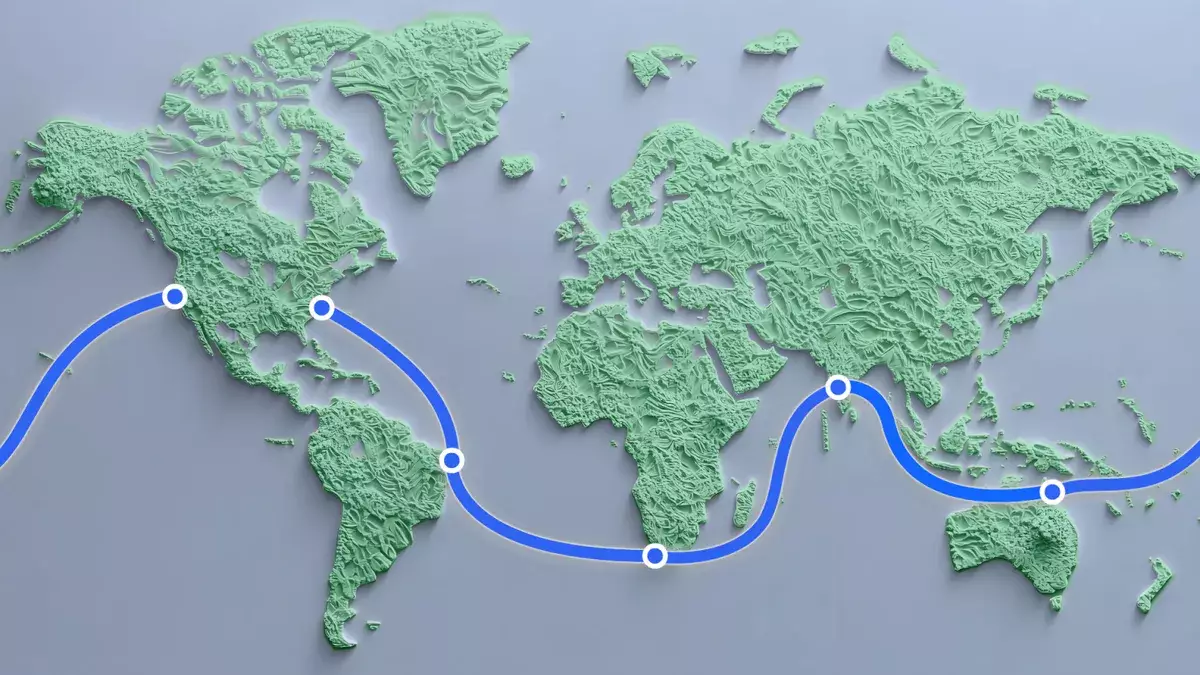As we stride confidently into 2025, the invisibility of our digital communications is often taken for granted. We live in an era where wireless technologies dominate, creating an illusion of effortless connectivity. However, beneath this superficial layer lies a more cumbersome reality: a staggering 98% of internet traffic is still carried through extensive networks of undersea cables. Meta, the tech giant formerly known as Facebook, is embarking on an audacious project to enhance global internet connectivity—Project Waterworth, a revolutionary underwater cable that promises to stretch further than the Earth’s circumference, demonstrating a visionary commitment to infrastructure that belies its online reputation.
Meta’s new cable is set to blanket an ambitious 31,000 miles (50,000 kilometers). This extensive network will forge connections between major global hubs: the United States, India, South Africa, Brazil, and even extending to Australia. The cable will not follow a simple linear route; instead, it will navigate the complexities of underwater topography, initiating on the eastern coast of the U.S., journeying down to Brazil, then diagonally crossing the Atlantic basin toward Africa. After skirting the continent, it will head to Mumbai and finally make its way across the Pacific back to California. Such a meticulously planned route is indicative of a strategic move not just for connection, but for solidifying Meta’s presence across diverse markets.
The technical specifications of Project Waterworth are as impressive as its reach. With sections laid at depths reaching up to four miles, the project aims to employ cutting-edge engineering techniques to maximize cable resilience. According to Meta, this includes innovative burial practices in areas prone to hazards such as maritime traffic and seismic activity. The introduction of 24 fiber pairs—a first of its kind—enables higher data transmission speeds while ensuring that this complex undertaking can be laid out swiftly, significantly increasing network capability across continents.
The commitment to integrating advanced routing strategies under such conditions highlights how crucial infrastructure is for sustaining the growth of the digital economy. With businesses increasingly reliant on fast and reliable internet connectivity, this endeavor speaks to a future where AI and other digital innovations can flourish without the crippling constraints imposed by inadequate bandwidth.
While Project Waterworth stands as a testament to Meta’s investment in physical infrastructure, it juxtaposes the company’s mixed reputation in the digital arena. Recently, CEO Mark Zuckerberg’s controversial decisions regarding content moderation have attracted criticism, particularly the shift from rigorous fact-checking to user-generated “community notes.” While this pivot aims to reduce censorship and empower users, it raises concerns about the proliferation of misinformation on these platforms.
This duality in Meta’s operations—fostering global connectivity while struggling with accountability and responsible content management—forces us to ponder deeper questions about the role of tech giants in shaping the digital landscape. The company is certainly capable of monumental projects that enhance global communications, yet it must also grapple with the societal implications of its online platforms.
The implications of Project Waterworth extend beyond mere infrastructure. As countries increasingly rely on the internet for economic growth, healthcare, education, and more, investments like these are crucial for bridging the global digital divide. Reliable connectivity can transform societies, fostering inclusion and enabling innovation across geographical and socio-economic barriers.
Meta’s ambitious project could pave the way for new digital corridors that empower regions presently underserved by technology, thereby promoting an interconnected world. Nonetheless, it remains essential for the company to address the socio-political ramifications of its platforms proactively to ensure the benefits of such technological advancements are realized universally.
As we observe Meta’s endeavors in developing Project Waterworth, we stand on the precipice of an exciting yet challenging digital future. This massive undersea cable represents not just an engineering marvel, but a statement of intent regarding the need for robust infrastructure in a world increasingly driven by digital interactions. It exemplifies the potential for technology to act as a bridge rather than a barrier, provided that companies like Meta remain vigilant in ensuring their platforms contribute positively to societal development. The journey ahead is fraught with challenges, but it is one that promises to connect us all in unprecedented ways.

